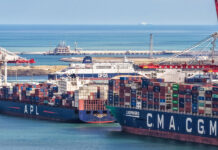September and October will be dominated by the sinking operation of the lock gate chamber of the outer head (number 1 in the picture) and by the construction of the walls of the flood defence (number 2 in the picture). The OpenIJ concrete mixing plant (number 3 in the picture) will be very busy again, as it has to produce a lot of concrete for the construction of the various parts of the lock.
The sinking operation of the lock gate chamber has begun
Early this September, OpenIJ has begun the sinking operation of the lock gate chamber of the outer head. This sinking operation marks an exciting phase in the construction project of the new sea lock. The lock gate chamber (the caisson), which has the size of a block of flats, will sink centimetre by centimetre into the ground. By excavating (washing away) the sand underneath the structure, the caisson’s own weight will cause it to sink further and further down to its predetermined final position. This process is largely automated and will be monitored by CCTV cameras installed under the floor of the caisson. Visitors of SHIP (the Lock and Port Information Centre) are given a detailed explanation in six steps of the entire sinking operation. It is really worthwhile visiting SHIP.
The walls of the flood defence
Also in September and October, OpenIJ will be continuing with the construction of the walls of the flood defence near the IJmuiden North Lock. When completed, this flood defence will be part of the primary water-control structure in the Netherlands and therefore has to be built to a height of approximately 8.85 metres above NAP (Normal Amsterdam Level). The part of the new public road called Middensluisweg will be built on top of this flood defence. The flood defence, between the North Lock and the new sea lock, will be made of concrete L-Walls.
The concrete mixing plant in full operation
A lot of concrete is needed for the production of these L-Walls. This concrete is produced by OpenIJ’s own concrete mixing plant. All concrete used for the new sea lock is manufactured here. Concrete is used for the construction of various parts of the lock, such as the lock gate chambers of the outer and inner head and their corresponding lock sills. The builders also need a lot of concrete for the lock chamber walls, the anchor beams of the lock chamber, and the walls of the flood defence.





